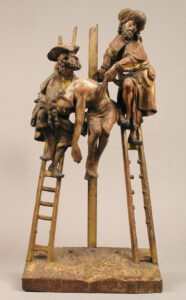
“When the shepherd becomes a wolf, the first duty of the flock is to defend itself. It is usual and regular, no doubt, for doctrine to descend from the bishops to the faithful, and those who are subject in the faith are not to judge their superiors. But in the treasure of revelation there are essential doctrines which all Christians, by the very fact of their title as such, are bound to know and defend. The principle is the same whether it be a question of belief or conduct, dogma or morals.”
— (The Liturgical Year, Dom Guéranger Vol. 4 Septuagesima, p. 379-380)
THE man the world recognizes as pope and supreme ruler of the Catholic Church, who proclaimed in the first year of his pseudo-reign, “I want a mess,” is gravely ill. While Francis may recover from this latest health crisis, his remaining days on earth are clearly to be few. It is likely his condition is worse than is being publicly let on today.
As he lies ill at Gemelli Hospital in Rome, may God have mercy on the many victims of this audacious vulgarian, head not of the Catholic Church but of the One-World Ekumenik Church. As an indicator of just how bad off the institution he led is, the city of Boston, once a stronghold of Catholicism, now has one seminarian per nearly 30,000 nominal Catholics, while the city of Chicago has one seminarian for every 67,000 parishioners. (And sadly, those seminarians will never be true Catholic priests, no matter how well-intentioned they are.)
Highlights from his false pontificate in 2014 alone include:
Held the first Muslim/Jewish prayers and Koran readings at the Vatican; Sent an iPhone message to evangelicals through prosperity-gospel TV preacher Kenneth Copeland; Peace doves attacked; Said to ‘scold the Lord‘ and also that he would baptize aliens; Cover of Rolling Stone; Accidentally said ‘the F word’; Cardinal Dolan claimed Francis said ‘Catholic Church should not dismiss gay marriage‘; Mentioned re-thinking celibacy for priests; Said he’s ‘not interested in converting evangelicals to Catholicism‘; Initial synod document suggested shift in Church’s position on homosexuality, but was revised; Said man is ‘the king of the universe!‘; Told a woman in invalid marriage it’s alright to take Holy Communion, saying ‘A little bread and wine does no harm‘; Compared Islamic terrorists to Christian fundamentalists…
But, the purpose of this post is to focus on the countless casualties, not on the state of Francis himself. The people harmed by this outrageous imposture that a man who joked about the Crucifixion, who said “Communists think like Christians” and who rejects key doctrines of Catholic belief and its sacred rites can be head of the Church include the following:
*Protestants repelled by his clearly immoral, anti-Christian statements, his eager support for the flooding of Western countries with immigrants, and his enthusiasm for every globalist U.N. agenda, including the Covid fraud. Francis has scandalized them and confirmed many in their obstinate blindness against the unshaken spiritual authority of the papacy which comes from Christ himself.
*Muslims, Maoists, Buddhists, voodooists, Jews, and assorted pagans who have been led to believe they worship the same God as Catholics. They too have been confirmed in their errors and continually given the impression that objective truth in spiritual matters does not exist. Francis went so far as to wish Muslims a Happy Ramadan: “I also think with affection of those Muslim immigrants who this evening begin the fast of Ramadan, which I trust will bear abundant spiritual fruit.” (Homily given at Lampedusa on 8 July 2013 with illegal Muslim immigrants)
*The people all over before whom Francis has insulted and apologized for the martyrs and saints of the past, dragging the name of Christ’s Church through the mud.
*Sincere, would-be Catholics deceived into believing Francis is a true pope when he is not even so much as a member of the body he claims to govern. The spiritual harm to them is incalculable and most have lost the true faith. Many are woefully uneducated about their faith and do not even know of the many anti-popes in Church history.
*Would-be Catholics offended by Vatican II apostasy who yet believe a heretic and apostate such as Francis can somehow be a true pope and that it is permissible to refuse him submission, thereby destroying all honor due to the papacy. (This is known as the “recognize-and-resist” position.)
Read More »







